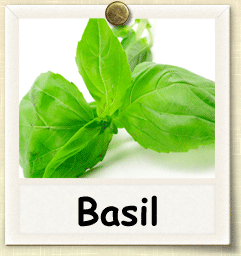|
Home > Guides > Herbs > Basil |
|
How to Grow Basil | Guide to Growing Basil |
|
|
| |
 |
|
Overview |
|
|
|
|
|
| |
|
| |
Featured in cuisines across the globe, basil is an indispensable flavoring. Plant seeds or transplants after all danger of frost has passed and soil is warm, and it will yield an abundant harvest within weeks. |
|
| |
|
|
| |
Growing Guide
GROWING NOTES
Prefers fertile soil.
Needs 6 at least 6 hours of sun per day.
Prefers steady moisture and warm soil.
MAINTAINING
Plant basil in fertile soil in a spot that gets direct sun for at least 6 hours per day. Pinch the tip from the center shoot of basil after it has grown for 6 weeks to force side growth and prevent early flowering. If flower stalks develop, simply snip them off.
Basil needs a steady supply of moisture and warm soil temperatures to produce well, so you have to play a balancing act with mulch. In cool areas, delay mulching until the soil temperature has reached the mid-60s. Where summer really heats up and soil loses moisture quickly, you can add mulch sooner.
This heat-loving herb is susceptible to even mild frost; harvest the remainder of your crop if temperatures are predicted to dip into the 30s.
Basil has few pests, but occasionally generalist pests such as aphids, flea beetles, and Japanese beetles will feast upon it. Rinse off aphids with a garden hose. To prevent beetles from munching, cover the crop with fabric row cover. If slugs are a problem on new transplants, try a barrier of copper flashing.
Diseases are more of an issue for basil-lovers. Fusarium wilt of basil, first identified in the early 1990s, arrived via infected seed imported from Italy. Symptoms include sudden wilting and leaf drop, accompanied by dark streaks on the stems, usually in weather above 80°F. If you notice these signs, quickly dig up the infected plant, along with all soil around the roots, and discard it. If part of your garden becomes infected, avoid spreading the disease by moving soil around on your tools or tiller, and consider growing your basil in containers. You might also try a fusarium-resistant variety, such as ‘Nufar’.
Basil is also susceptible to a few bacterial rots that show up on stems or leaf clusters, usually in cool, wet weather, often late in the season. Keys to control include planting in well-drained soil, spacing plants so they dry off after rain, and removing infected plants from the patch.
|
|
| |
|
| |
|
|
| |
|
|
| |
Harvesting Guide
HARVESTING
Basil is at its most flavorful when fresh. The best time to harvest is just as the plant starts to set flower buds, well before flowers bloom. Basil is programmed to initiate flowering when it has six pairs of leaves on a stalk. For maximum production per plant, cut it back to two leaves per stem, and don’t let it grow past four pairs. You can harvest the entire plant about every three weeks, and at the end of the season there will be 12 to 24 lateral branches.
The later in the day you harvest basil, the longer it stays fresh. In a perforated bag kept at around 60°F, it will keep for 10 to 14 days. In contrast, refrigerated basil lasts two or three days. You can also store stems in a vase in your kitchen, close at hand for cooking. As for flower bouquets, change water in the vase every few days.
To best maintain the flavor of dried basil, store it in the freezer. To quick-freeze basil, dry whole sprigs and pack them in plastic bags with the air pressed out. To dry basil, pinch leaves off the stem and spread them out in a shady, well-ventilated area. Check in 3 or 4 days, and if they don’t crumble easily between your fingers, finish drying in the oven; otherwise the leaves may turn brown or black in storage. Use the lowest heat possible with the door slightly open, turn leaves for even drying, and check them frequently.
Another method is to make pesto (or even basil processed with olive oil), pack it into containers or ice cube trays, and freeze it. Once cubes are frozen, you can pop them out of trays and into plastic bags for easy storage.
SAVING SEEDS
Pinch back all season until fall I let them flower and dry. I pluck of the tips of the dried flower stalk and lay it on a paper plate. I let it stay there for a few days and then I hold the plate in one hand while I tap the side with the other. Those little black seed just roll out and gather at the bottom of the plate. It really is easy. I do the same for my Coleus.
Dry the leaves in the dehydrator and use them during the winter. I suppose if you dried enough you could put them in small jars and give them as gifts. If you have a good bit of garlic, Sams has pine nuts you could make pesto. With pesto you can freeze it in ice cube trays and then put in ziplocks
|
|
| |
|
|
|
| |
|
|